STMicroelectronics is simplifying the design and volume production of the new generation of reliable small, low-cost satellites to deliver services like earth observation and broadband internet from low-earth orbits (LEOs).
ST’s new series of radiation-hardened power, analog, and logic ICs in low-cost plastic packages provide important functions for the satellites’ electronic circuitry. The first nine devices in this series have just been released and include a data converter, a voltage regulator, an LVDS transceiver, a line driver, and five logic gates that are used throughout systems like power generation and distribution, on-board computers, telemetry star trackers, and transceivers. ST will continue to grow the series adding more functions in the coming months to further expand designers’ choices.
“We are in a new era of space commercialization and democratization, commonly called New Space, which radically changes the economics of conceiving, building, launching, and operating satellites. These formerly low-volume, specialized space vehicles are quickly becoming commoditized for deployment in large constellations sometimes comprising several thousands of units,” said Marcello San Biagio, General Purpose and RF Division General Manager, STMicroelectronics. “Our new product series brings the know-how we have amassed supporting space missions for many decades, combined with our expertise in commercial IC production, to deliver competitively priced products robust enough to withstand the challenges of the LEO environment and, in particular, meeting the requirement for radiation hardness.”
Prices for ST’s new LEO series components range from $70 for logic ICs to $450 for the data converter for orders of 1000 pieces through ST distribution partners. Development Model prices are from $135 to $775 for 10 pieces. Please contact your local ST sales representative for specific pricing information.
Technical Notes to Editors:
LEO satellites receive more atmospheric protection and are exposed to lower levels of radiation than traditional satellites launched into higher, Geostationary Earth Orbits. In addition, they are designed for shorter lifetimes. While the required performance and quality assurance for electronic components to be used in LEO satellites are close to those for traditional satellites, the level of immunity required is lower. Historically, parts for space applications have been housed in hermetically sealed ceramic packages to pass rigorous QML or ESCC qualification and production processes, resulting in a relatively high cost for these typically low-volume components.
ST’s new LEO rad-hard plastic parts are ready to use in New Space applications, with optimized qualification and production flows and economies of scale. They require no additional qualification or up-screening from their users, and therefore eliminate significant cost and risk.
The series ensures a radiation hardness match to the LEO mission profile, with a Total Ionization Dose immunity up to 50 krad(Si), high immunity to Total Non-Ionizing Dose and Single Event Latch-up (SEL) immunity up to 62.5MeV.cm²/mg. The parts are assembled on the same production line used for ST’s AEC-Q100 automotive-qualified ICs, allowing the LEO series to benefit from the statistical process control that enables high-volume production at consistently high quality. The parts outgassing is characterized to ensure it stays within the commonly accepted limits of New Space. External terminations’ finishing ensures the absence of whiskers in space, while being compatible with both leaded (Pb) and pure tin mounting processes as well as REACH compliant.
The nine new parts announced today are the LEO3910 2A adjustable low-dropout voltage regulator, the LEOAD128 8-Channel, 1Msps 12-bit Analog-to-Digital Converter (ADC), the LEOLVDSRD 400Mbps LVDS driver-receiver, LEOAC00 quad 2-input NAND gate, LEOAC14 hex inverter with Schmitt-trigger input, LEOA244 octal bus buffer with tri-state outputs, LEOAC74 dual D-type flip-flop, LEOAC08 quad 2-input AND gate and LEOAC32 quad 2 inputs OR gates.
For more information please go to www.st.com/leo













